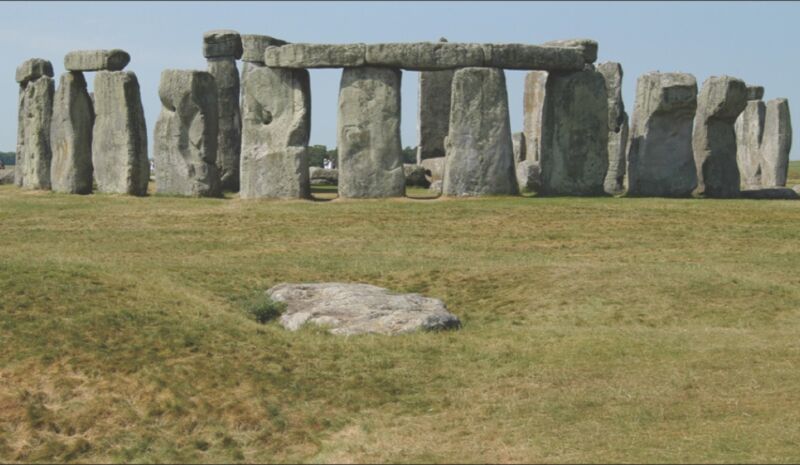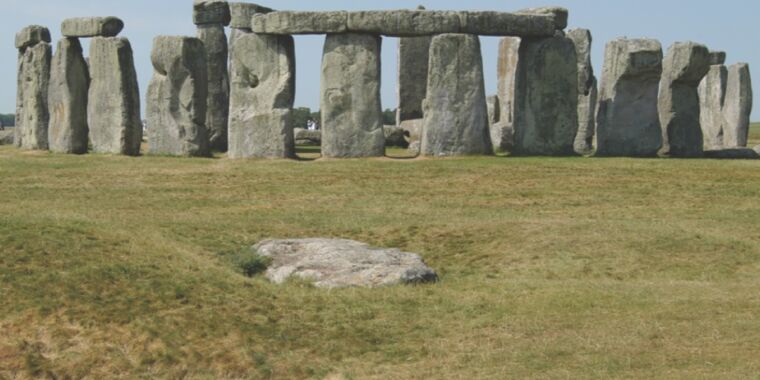
Timothy Darvill
Stonehenge was an important place for thousands of years before people placed the first stones, according to a recent study. Archaeologists used the microscopic remains of insects, pollen, fungal spores, and ancient DNA preserved in the soil to reconstruct the ancient environment of southwest England’s Salisbury Plain. Six-thousand years ago, the plain was a mosaic of open grassland and woods, where archaeological evidence shows that people once hunted herds of extinct cattle called aurochs.
Samuel Hudson, an environmental scientist at the University of Southampton, and his colleagues say their findings suggest that many of the ceremonial sites and routes left behind by Britain’s earliest farmers—the builders of Stonehenge—may date back thousands of years to land used by the first occupiers of Britain after the end of the last Ice Age.
What happens when worlds collide?
About a mile away from Stonehenge lies an older, less famous archaeological site called Blick Mead. Here, the Salisbury Plain meets the floodplain of the River Avon. Stone tools (more than 100,000 of them), butchered animal bones, and charred fish bones show that people came to this place repeatedly for thousands of years during the Mesolithic period.
When Hudson and his colleagues radiocarbon dated material from the oldest layers at Blick Mead, they found that people had been hunting, fishing, and eating at the site as early as 8000 BCE. It’s probably not a coincidence that a precursor to Stonehenge dates to around the same time: a ring of pine posts that stood a bit more than half a kilometer away from the much later site at Stonehenge.
The people who built the wooden circle and hunted at Blick Mead were descendants of the first people to set foot in Britain after the glaciers receded: hunter-gatherers closely related to the 10,000-year-old “Cheddar Man” and, probably, to the people who practiced ritual cannibalism in what’s now Somerset.
Material from the youngest layers at Blick Mead dates to around 3400 BCE, a few centuries after a new group of people arrived on British shores. Those new settlers were the descendants of people from the eastern Mediterranean, in what’s now Turkey, and they brought a new way of life with them—one based on farming and raising livestock. The Neolithic period had come to Britain.
A few centuries later, around 3000 BCE, the descendants of the newcomers dug a circular ditch, backed up by an earth embankment, to surround a ring of holes in which they buried the cremated remains of the dead. This location was the first phase of construction at what is now Stonehenge.
In Britain’s archaeological record, the transition from hunter-gatherer culture to early farming culture is abrupt. With one interesting exception, we don’t get to see what happened when those first farmers arrived and met indigenous hunter-gatherers. We just see that suddenly, traces of Neolithic culture replace what came before.
But Hudson and his colleagues say the landscape itself holds some important clues.
A wide-open landscape
Hudson and his colleagues sifted through ancient soil at Blick Mead, looking for tiny traces of the past environment: pieces of long-dead insects, pollen grains, and fungal spores. They even sequenced ancient DNA from the soil, which revealed more information about the species of plants, animals, and fungi that had lived and died near the site. Radiocarbon dating and optically stimulated luminescence (which measures how long it’s been since mineral grains were exposed to sunlight) were also obtained from each soil layer at the site. This let the archaeologists track how the environment near Blick Mead and Stonehenge changed over several thousand years.
It turned out that around 6000 BCE, the area around Blick Mead was primarily woodland scrub, where apple, dogwood, and ivy grew, along with willow and horsetail closer to the river. Over the next few centuries, though, that scrub forest gave way to a large, open meadow amid a patchwork landscape of grassland, forest, and wetland.
In other words, it was the perfect landscape for herds of wild cattle to graze—and for people to hunt them. And for roughly 4,500 years, that’s exactly what happened at Blick Mead.
Some Mesolithic sediment layers at the site still hold the hoofprints of long-extinct aurochs, and more than half the animal bones archaeologists have unearthed there come from that animal. That’s unusual in the UK, where wild boar and red deer seem to have made up a more significant proportion of Mesolithic people’s diets.
But the area around Blick Mead was special, and the hunter-gatherers who lived here clearly knew it.
The aurochs herds likely played a significant role in keeping the meadow clear; Hudson and his colleagues found DNA and pollen from plants like clover, sheep’s sorrel, and forget-me-nots, which tend to grow where sheep or cattle graze and then fertilize the soil with their dung. And fungal spores in the site’s sediment include species that tend to thrive in dung-enriched soil. Besides a few stone ax-heads unearthed at the site, archaeologists haven’t found any direct evidence that people actively maintained the meadow by clearing trees. Still, hunter-gatherers elsewhere in the world have found similar ways of managing their hunting grounds.








